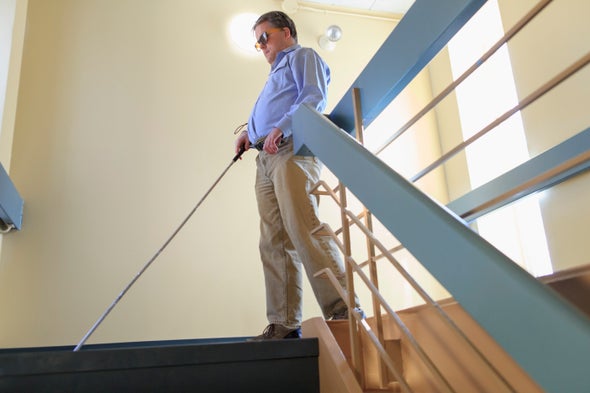(单词翻译:单击)
听力文本
This is Scientific American — 60-Second Science, I'm Susanne Bard.
The human brain is remarkably adaptable, constantly being shaped by life experience. A striking example is that in blind people, the brain's visual cortex is repurposed for auditory tasks—such as detecting motion and pinpointing where a sound is coming from. But its adopted functions could be even more complex.
"And the question is, well: How much can this part of the brain change its function in people who were born blind?"
Johns Hopkins cognitive neuroscientist Marina Bedny. She and her team had blind and sighted volunteers listen to audio clips from entertaining movies while undergoing functional MRI scans of their brains. The goal was to find out if, among blind people, the visual cortex is activated consistently for complex auditory tasks.
"So we take brain activity in one person, and we correlate it to brain activity in another person. It gives you a way to directly compare how similar the processing of two brains is when they're listening to a given stimulus. And so that can tell us, for example, whether the visual cortices of different blind people are doing the same thing at the same time."

The result?
"You get massive synchrony over something like 65 percent of the occipital lobe, which is a lot of cortical territory."
In other words, in blind participants, most areas of the visual cortex were activated at the same time by the movie audio.
But the visual cortices of sighted people didn't show consistent activation. What's more, the similarities became much less pronounced among the blind participants when the movie clips were scrambled and became meaningless. That finding suggests the visual cortex isn't just acting like a simple sound processor.
"And that's important because it means that this brain region likely went from being a low-level sensory area to behaving like a higher cognitive area, which suggests a very extreme level of reorganization and plasticity."
The study appears in the Journal of Neuroscience.
Further research will investigate other ways in which life experiences may profoundly shape cognitive function, from reading braille to programming computers.
Thanks for listening for Scientific American — 60-Second Science. I'm Susanne Bard.
参考译文
这里是科学美国人——60秒科学系列,我是苏珊娜·巴德。
人类大脑具有非常强的适应能力,而且不断受到生活经历的影响。一个有力例证是,盲人大脑的视觉皮层被转用于听觉任务——比如检测运动和确定声音的来源。但其采用的功能可能更加复杂。
“问题是:先天失明者大脑的这一部分能在多大程度上改变其功能?”
约翰霍普金斯大学的认知科神经学家玛丽娜·贝德尼说到。她和团队让盲人和有视力的志愿者听娱乐电影的音频片段,同时对他们的大脑进行功能性核磁共振扫描。目的在于找出盲人的视觉皮层在处理复杂的听觉任务时是否一直处于激活状态。
“因此,我们将一个人的大脑活动与另一个人的大脑活动联系起来。这提供了一种方法,可以直接对比两个大脑在聆听给定刺激时的相似程度。这可以告诉我们,不同盲人的视觉皮层是否在同一时间做同样的事。”
结果呢?
“约65%的枕叶部分有大量同步,枕叶是大面积的皮质区域。”
换句话说,在盲人参与者中,视觉皮层的大部分区域同时被电影音频激活。
但有视力者的视觉皮层并未显示出一致的激活。更重要的是,当电影片段被打乱并变得毫无意义时,盲人参与者大脑的相似性也会明显减少。这一发现表明,视觉皮层不仅仅是简单的声音处理器。
“这一点非常重要,因为这意味着大脑这一区域可能正从低级感知区域转变为较高级的认知区域,这表明一种极端水平的重组和可塑性。”
这项研究发表在《神经学期刊》上。
进一步的研究将调查生活经历可能对认知功能产生重大影响的其他方式,这些经历的范围从阅读盲文到编程计算。
谢谢大家收听科学美国人——60秒科学。我是苏珊娜·巴德。
译文为可可英语翻译,未经授权请勿转载!
重点讲解
重点讲解:
1. listen to (注意地)听;
He spent his time listening to the radio.
他听收音机打发时间。
2. find out (尤指特意通过努力)发现,找出,查明;
I want you to do everything you can to find out who's responsible.
我希望你能尽一切可能找出责任人。
3. at the same time 同时;
Photographs taken at the same time on two consecutive sunny days can be quite different from one another.
在连续两个艳阳天的同一时间拍摄的照片也可能大不相同。
4. what's more 更有甚者;更为重要的是;此外;
You should remember it, and what's more, you should get it right.
你应该记住它,更重要的是,应该正确理解它。


